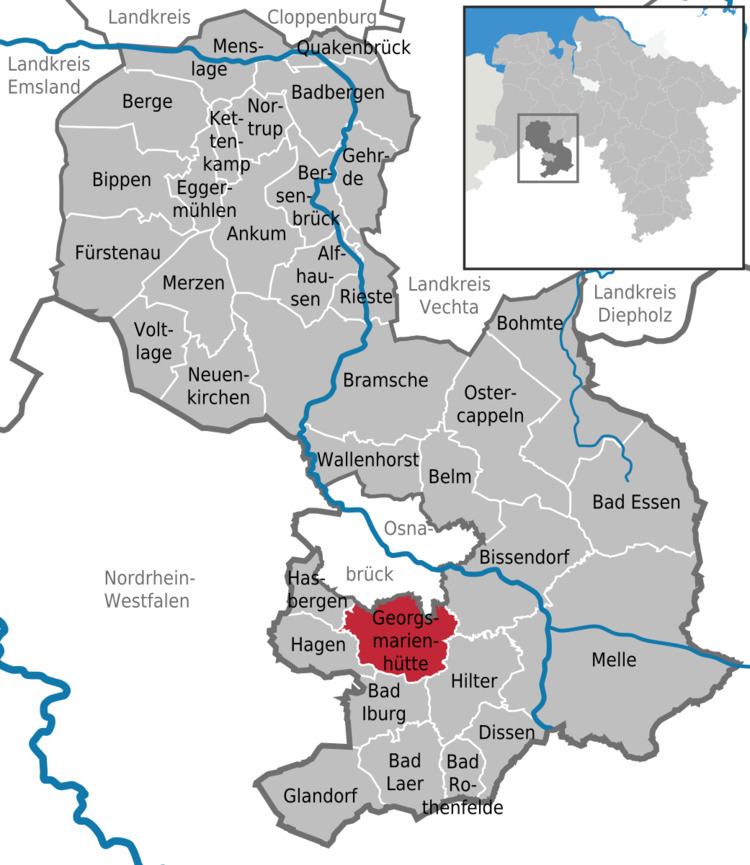Time zone CET/CEST (UTC+1/+2) Area 55.41 km² Postal code 49124 | Elevation 86-331 m (−1,000 ft) Postal codes 49124 Population 32,289 (31 Dec 2008) Local time Sunday 5:54 PM | |
 | ||
Weather 11°C, Wind E at 13 km/h, 47% Humidity | ||
Georgsmarienhütte is a town in the district of Osnabrück, in Lower Saxony, Germany. It is situated in the Teutoburg Forest, approx. 7 km south of Osnabrück.
Contents
- Map of 49124 GeorgsmarienhC3BCtte Germany
- History
- Kloster Oesede
- Transportation
- Education
- Museums
- Twin townsSister cities
- Notable People
- Connected to Georgsmarienhtte
- References
Map of 49124 Georgsmarienh%C3%BCtte, Germany
History
In 1856 the "Georgs-Marien-Bergwerks- und Hüttenverein" erected an iron and steel works in the municipality Malbergen. It was named by King George V of Hanover who supported industrial development, and his wife Marie. The company was called Georgsmarienhütte. The workers’ housing estates grew and developed to the municipality Georgsmarienhütte. Malbergen became part of Georgsmarienhütte in 1937. In 1970, the municipalities Oesede, Kloster Oesede, Harderberg, Holsten-Mündrup, the southern part of Holzhausen and the "industrial village" Georgsmarienhütte were united to the city Georgsmarienhütte.
The iron and steel works were one of the most important employers south of Osnabrück, employing several thousand people. Since 1923 it belonged to Klöckner Werke AG which suffered severely from 1990's steel crises. In 1993, Klöckner manager Jürgen Großmann bought the steel works for a symbolic amount of money and transformed it to an efficient company which is one of the leading high grade steel producers in Europe.
Kloster Oesede
The most important historical building is the church of former convent Kloster Oesede dating from the 12th century. The Benedictine convent was founded by count Ludolf von Oesede (d. 1184) and his wife Thedela for which he donated his castle complex in the first half of the century. The convent gave its name as well to the former settlement Sutorpe. Kloster Oesede now is a part of the city Georgsmarienhütte. The convent was the first one in the district of Osnabrück. The convent’s first prior was Ludolf’s eldest daughter Goda. On January, 15th 1170 conventional life began. The convent became wealthy within the centuries by donations and the nuns' labour. It existed until 1803 when it was secularisated by the Reichsdeputationshauptschluss. The convent buildings from the Middle Ages were taken down between 1790 and 1803. Only the Alte Abtei (Old Abbey) remained. A new two-storey building was erected by Alexander Ludwig von Corvey (1670–1728) in 1723. It still exists and is used for partly parish and school purposes. The former convent’s church in which the donator count Ludolf and his wife were buried now is the Roman Catholic parish church St. Johann. A remarkable detail of the church is the Hagioscope which allowed lepers to join the service from outside. Another hagioscope was exposed nearby in St. Clemens, the monastery’s church in Bad Iburg.
Transportation
Georgsmarienhütte is served by the Osnabrück–Brackwede railway line which in turn leads to the rest of the country.
The city of Osnabrück is connected by road to the Autobahn A1, A30 and A33. In addition, there are regular and frequent bus lines with Osnabrück, as well as the surrounding countryside.
The nearest airport is the Münster Osnabrück International Airport at a distance of 32 kilometers.
Education
All of the types of German grammar schools are represented in the city. In addition to a folk high school, two boarding schools provide adult education in special courses which usually last a few days.
Museums
Museum Villa Stahmer is a museum of local history. The building was erected in 1900 by factory owner Robert Stahmer. He lived there with his family until 1907. It was in residential use until the end of World War II when it was used by British forces. Since 1947 it was used as an employment agency. In 1980, the museum was opened.
Twin towns—Sister cities
The City Georgsmarienhütte is twinned with:
